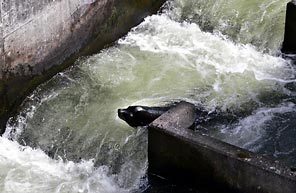forum
library
tutorial
contact

Killing Sea Lions Will Not
Save Columbia River Salmon
by John BalzarSeattle Times, February 7, 2008
|
the film forum library tutorial contact |

|
Killing Sea Lions Will Not
by John Balzar |
 When the government gets ready to kill predators in a desperate effort to save prey, you can be sure that something's way wrong in nature. And these days, what's wrong can usually be traced to human mistakes.
When the government gets ready to kill predators in a desperate effort to save prey, you can be sure that something's way wrong in nature. And these days, what's wrong can usually be traced to human mistakes.
That's exactly the situation on the great Columbia River at Bonneville Dam.
Here, the federally protected sea lion swims in troubled waters with the chinook salmon, and bad news is brewing.
To step back: The people of the Pacific Northwest understand only too well why salmon stocks are suffering on the Columbia. Bonneville and the other dams that straddle the Oregon-Washington border have horribly compromised the fabled fish's ability to travel, reproduce, survive and thrive.
There also is the steady pressure of human fishing - both in the river and in the offshore ocean. Spawning streams upriver are despoiled by such things as clear-cut logging. And, oh yes, sea lions feed on some salmon during the spring chinook run. The latter fact happens to be a minor one in the larger story. According to scientists, sea lions eat just 4 percent of the chinooks that pass Bonneville.
Wouldn't you know it, though, some people cling to the false hope that killing sea lions at the dam will mitigate the larger problem. Logic, science and compassion all argue to the contrary, and sober-sided residents of the region need to sound off against this misguided notion. Killing sea lions will not save the salmon, but will - in fact - make things worse by wasting valuable time.
For instance, a recent federal impact analysis concluded that the greatest challenges facing the fish are the survival of juveniles and harmful hatchery practices. Predation by sea lions was not listed as a key factor limiting the salmon's recovery.
The real choice is not salmon or sea lions, it's whether to act wisely and increase salmon numbers or whether to add another management mistake to the long record of them while the fish are left to struggle.
Think of it this way: When you kill a sea lion, what takes his place?
You're right, another sea lion.
On Jan. 18, the National Marine Fisheries Service issued a proposal to kill up to 85 California sea lions near Bonneville Dam out of the 1,000 or so that are estimated to be in the Columbia River vicinity. The public has the opportunity to comment on this proposal until Feb. 19. Concerned residents need to speak out directly - for the sake of the salmon and all the wild creatures that play honorable roles in nature's economy.
The people of the Pacific Northwest rejoice in their proximity to wildness. I know. I've lived and worked there, and a share of my heart will always be in that corner of the country. Residents rightly credit themselves with a special degree of appreciation for the living panoramas that surround this wonderful region. They also understand that along the Columbia, we need more of nature in all its grand variety, not less - not when it's so very precious.
Government officials are in a tight spot, to be sure. But, they need to be reminded that there is no excuse to report back to headquarters that they are "doing something" if that something is wrong. This time, they're dead wrong. The salmon will not benefit from this diversion of management resources.
Sea lions are majestic creatures. They don't deserve to be made into that commonplace political species known as the "scapegoat."
John Balzar is senior vice president for communications at The Humane Society of the United States. He is the former Northwest bureau chief for the Los Angeles Times, and has resided in Portland as well as Seattle.
Related Pages:
Sea Lions vs. Salmon: Restore Balance and Common Sense by Fidelia Andy, Seattle Times, 2/15/8
Survival of Snake River Salmon & Steelhead Data compiled July 2004 by www.bluefish.org
learn more on topics covered in the film
see the video
read the script
learn the songs
discussion forum
